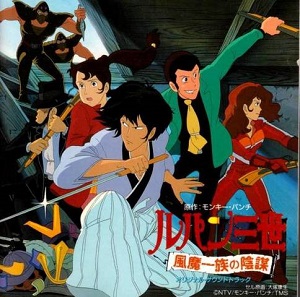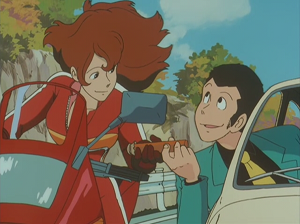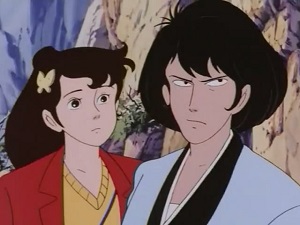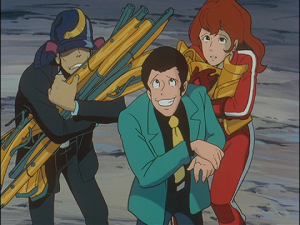50 YEARS OF LUPIN III: The Fuma Conspiracy
Sunday , 6, August 2017 Comics, Fiction, Movies 3 Comments Well, if it ain’t the smell of villain.–Lupin III
Well, if it ain’t the smell of villain.–Lupin III
In 1987’s direct-to-video movie The Fuma Conspiracy, the utterly unthinkable has happened: Goemon Ishikawa, famed ronin of the underworld, is getting married. The Lupin gang reunites to attend his wedding to Murasaki Suminawa, the daughter of his martial arts instructor. The wedding ceremony is interrupted by ninjas of the Fuma clan who try to steal a Suminawa heirloom vase but make off with the bride instead. Over the objections of his in-laws, and trusting in Lupin’s skills as a thief to retrieve it, Goemon trades the vase to the Fuma clan for Murasaki, unaware that the vase is a map to the hidden treasure of the Suminawa clan. Now the bride and groom must race to the family treasure to keep it from the Fuma clan’s clutches, aided by the master treasure hunter Lupin III.
If Dead or Alive was the Lupin III franchise’s take on a James Bond movie, The Fuma Conspiracy is its Indiana Jones, paying lip-service to thievery while sending Goemon, Lupin, and company through an underground maze of lethal traps to keep a legendary treasure out of the hands of a historical group of villains. For just like the Nazis, the Fuma clan of ninjas actually existed, and were feared for their strength, their murderous methods, and their utter lack of honor in battle. And, just like Raiders of the Lost Ark, an anti-hero must take on the mantle of a true hero to defeat them. On the Miyazaki to Monkey Punch scale of heroism to villainy, The Fuma Conspiracy is the most Miyazaki-like of any Lupin film to follow his Castle of Cagliostro.
In 1971, Hayao Miyazki was part of an emergency team called in to save the ratings disaster that was the pilot of first Lupin III television series (Green Jacket). He toned down Lupin’s ruthlessness, pleasure in the pain of others, and taste for violence and rapine, adding the guise of the goofy hero, a love for gadgetry, and heroic goals to the master thief’s personality. Fujiko’s sensuality was also muted, and the bonds between Lupin, Goemon, and Jigen were strengthened, making a fast gang out of three thieves that occasionally worked together. The final element added was the franchise’s now iconic care chases.

The Fuma Conspiracy takes these Miyazaki elements to their furthest extreme. As the true protagonist and hero of the movie, Goemon’s goals are exclusively heroic, rescuing his betrothed and saving his family’s treasure from cutthroat ninjas. Lupin and Jigen spend most of the movie helping Goemon whether he wants it or not, foiling the Fuma and pushing Murasaki into Goemon’s arms when honor and duty compel him to act on his own. Even Inspector Zenigata is given a heroic goal beyond the arrest of Lupin, as he dives headlong into the underground traps to rescue Murasaki and Goemon before the self-destruct timer buries the treasure forever. While Fujiko is the only member of the gang motivated in this adventure by loot, she’s been toned down as well. The rivalry and eternal flirtation between Fujiko and Lupin has been replaced by an agreeable friendship. When called upon by the plot to seduce a guard, Fujiko’s normally sensual charms have been replaced with the cringe-worthy cutesiness of a mddleschooler that just discovered boys. The film is so…innocent, a word rarely used with the Lupin franchise, and a far departure from its MAD Magazine meets Playboy roots. Even the violence is toned down, as even the Fuma ninjas receive the shoulder wounds and grazing shots normally reserved for heroes in westerns and action movies.
What isn’t toned down is the action. The movie barrels along at an energetic pace, buoyed along by the fluid cel animation. Both the car chase set-piece and Goemon’s samurai vs. ninja duels are lovingly depicted, fast, and furious in their pace. And none of the standard cost-saving animation tricks common to anime are present, from reused frames, long stretches of talking-head dialogue, and stationary characters. Characters in motion tend to stay in motion, even down to small gestures and reactions. Story-wise, The Fuma Conspiracy moves from the disrupted wedding, to rescuing Murasaki, to Fujiko’s infiltration of the Fuma, a car chase with Zenigata, braving the underground traps on the way to the treasure, and the final confrontation between Goemon and the Fuma clan’s leader. There are six action sequences in seventy minutes, yet the film does not feel rushed. What little exposition is needed manages to be learned in the heat of the moment, and creative use of perspective, such as a scene where Goemon and Murasaki watching from a train while Zenigata chases Lupin, allows many scenes to further multiple plot lines at the same time.

More so than most Lupin films, The Fuma Conspiracy relies on romance to move the plot forward. Unlike Lupin’s later wedding of convenience, Goemon and Murasaki’s wedding is driven by actual affection and love. Both Goemon and Murasaki repeatedly take risks to ensure the safety and happiness of each other, and these risks propel the plot forward. If their interactions have the air of high school sweethearts–or as much as the propriety-bound Goemon can manage–it is because, from Murasaki’s perspective, they are. She’s had an eye on Goemon since high school, and as she’s grown into womanhood, so has her love for Goemon. Their courtship was a long. slow simmer as opposed to the instant infatuations normal of the franchise. While this might be another sign of Miyazaki’s influence, it is also the only relationship that makes sense for Goemon as he has ignored more assertive and seductive women before. Unfortunately, this storybook romance is ruined at the end as Goemon’s stony samurai honor compels him to leave Murasaki at the end, for he wounded her while under the effects of hallucinogenic gas.
Idiot.
What man in their right mind would leave behind a woman not only willing to brave a ninja clan to be with her beloved, but one willing to shoot his attackers with a crossbow just make sure he is safe? And we’re not talking the “stop helping” messes that many girlfriends make when they try to help in adventure films. Murasaki carries her weight in finding the treasure, and if her crossbow bolts don’t kill the head of the Fuma clan, it is because he’s a ninja at the height of the ninja craze worldwide. But Goemon cannot unbend his honor long enough to face the consequences of his actions–or receive Murasaki’s ready forgiveness. And so the man who had proven repeatedly that he would sacrifice and even die for his future wife walks away from her at the end. All because, like any action franchise, the franchise’s status quo has to be maintained.

As one of the earlier Lupin films brought over from Japan, the translation efforts are plagued by the same sort of copyright issues that affected the original Arsène Lupin. For just as Maurice Leblanc did not have the rights to use the name and likeness of Sherlock Homes, Monkey Punch did not have the international rights to use the Lupin name. This forced earlier translations to use pseudonyms for Lupin. While the Wolf was a favorite replacement for Lupin, the original English translation for The Fuma Conspiracy used an alternate pronunciation, Rupan, instead. Monkey Punch eventually worked out an arrangement with Leblanc’s estate, in time for the English release of Dead or Alive and other Lupin movies in the early 2000s. As this retrospective continues to near its conclusion, we will see more of the pseudonyms.
It is a shame that The Fuma Conspiracy is out-of-print, as it is a fun adventure for all ages, showing many of the strengths of anime from a time when the medium still courted audiences of all ages and walks of Japanese life. While its innocence and joyous action places The Fuma Conspiracy out of step with the rest of the Lupin franchise, this movie would make an excellent addition to the collection of any anime enthusiast or adventure movie fan willing to spend the effort to hunt it down.

Yeah that perverted sense of honour. I must leave you even though we love each other and you’ve been stand up throughout the ordeal. I hate it! It’s totally out of place, morally repugnant as well as a civilizational effrontery.
It just smacks of psychopathic ingratitude from a morally stunted character. It also represent very bad writing.
xavieer
Enjoying the series.
One of these songs would not exist without the other (the easy tell is at 1:33 in the Basia song and… the exact same spot in the Fuma theme song):
https://www.youtube.com/watch?v=cYZ1mjvu7Rg